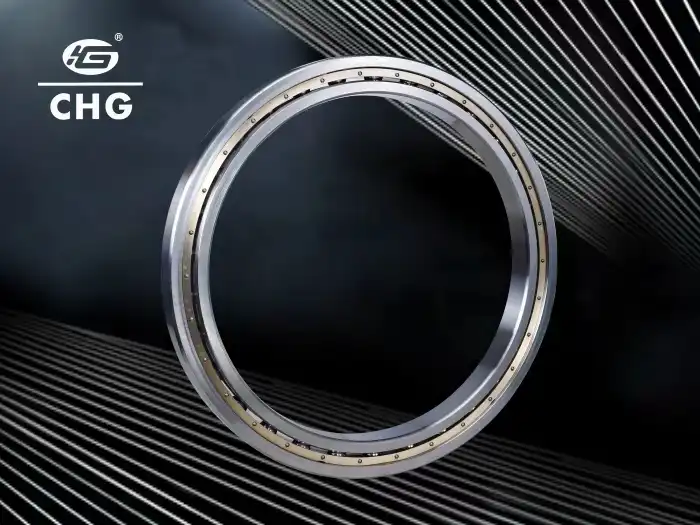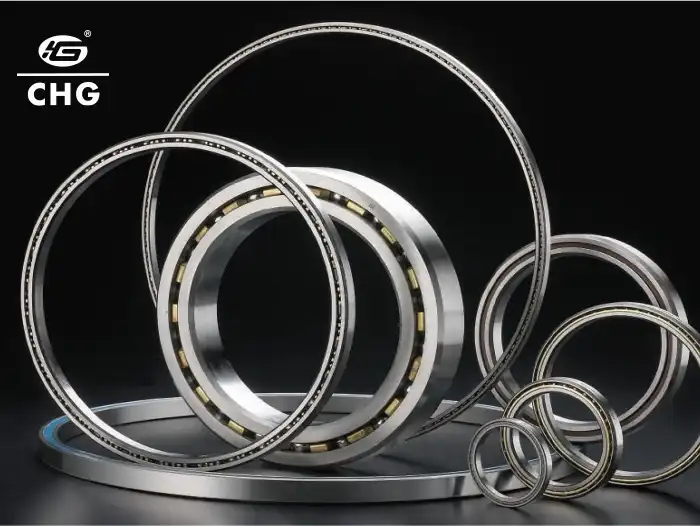How Do Thin Section Ball Bearings Support Robotics and Automation?
Thin Section Ball Bearings play a crucial role in advancing robotics and automation technologies. These specialized bearings are designed to provide high precision and performance within a compact form factor, making them ideal for applications where space is at a premium but accuracy is paramount. In the rapidly evolving fields of robotics and automation, where every millimeter counts and smooth operation is essential, thin section ball bearings offer a unique combination of space efficiency, reduced weight, and exceptional performance. Their slim profile allows for more compact designs in robotic joints and automated machinery, while their ability to handle both radial and axial loads ensures stability and precision in complex movements. As industries continue to push the boundaries of what's possible in robotics and automation, thin section ball bearings stand out as a key component, enabling innovations that were once thought impossible due to size constraints or performance limitations.
What Are the Key Advantages of Thin Section Ball Bearings in Robotics?
Space Efficiency and Weight Reduction
Since of its capacity to decrease weight and maximize space economy, Lean Area Ball Orientation offer noteworthy benefits in mechanical autonomy. Since of their thin profile, these heading may be utilized in compact robot plans without compromising execution. In the world of mechanical technology, where each millimeter and gram things, the utilize of Lean Segment Ball Heading makes robots lighter and more spry. This lessening in weight can essentially progress the vitality economy and payload capacity of mechanical arms. Engineers are able to make more complex and flexible mechanical frameworks since of the space-saving plan of these heading, which opens up unused conceivable outcomes in robot plan and working.
Precision and Smooth Operation
Thin Section Ball Bearings are the gold standard for robots when it comes to precision and seamless operation. Crafted with utmost care, these bearings provide absolute accuracy in every robotic movement. The reduced profile thickness of these bearings allows for a larger ball complement, which in turn reduces friction and improves load distribution. Robotic control and repeated motions rely on smooth functioning, which this achieves. The bearings and robotic parts last longer since there is less friction, which in turn generates less heat. Thin Section Ball Bearings are perfect for robotic arms and automated assembly lines because they maintain their accuracy even during high-speed operations.
Versatility in Load Handling
Lean Segment Ball Orientation illustrate surprising flexibility in taking care of different sorts of loads in mechanical applications. The modest profile and great control of outspread and pivotal loads make these heading crucial for multi-axis mechanical developments. One kind of bearing may regularly oblige numerous joint arrangements, which permits for more customization in robot plans. Sparse Part Ball bearings are capable of withstanding small loads that are often applied by automated arms and are attached to the outside of the bearing. The performance and mobility of mechanical frameworks are enhanced by enabling more sophisticated and dynamic mechanical advances.

How Do Thin Section Ball Bearings Enhance Automation Systems?
Improved Efficiency in Automated Processes
Automation systems are made much more efficient with the help of Thin Section Ball Bearings because of their exceptional performance and distinctive design. These bearings enable processing equipment and automated production lines to be designed with smaller machinery, which optimizes space on factory floors. Thin Section Ball Bearings improve operational efficiency by reducing energy consumption in automated systems due to their reduced friction and smooth operation. For automated manufacturing processes to save waste and keep product quality high, its accuracy is essential for constant and exact motions. In addition, automated systems can accelerate and decelerate faster using these bearings because of how lightweight they are, which increases throughput and decreases cycle times.
Durability and Reduced Maintenance
Durability and reduced maintenance requirements are key advantages that Thin Section Ball Bearings bring to automation systems. Enhanced wear resistance and extended operating life are outcomes of the specific production procedures and high-quality materials used to make these bearings. Because of its long service life, Thin Section Ball Bearings require fewer replacements and have less downtime in continuous operation situations common to automation systems. They have a longer lifespan because their design permits superior sealing choices, which prevent impurities and lubrication loss. Automated production lines rely on greater system dependability to keep running efficiently and productively, and the decreased maintenance demands help achieve both of these goals.
Flexibility in System Design
Engineers are able to come up with more imaginative and effective arrangements since to the expanded plan flexibility advertised by Lean Segment Ball Orientation in mechanization framework design. Particularly helpful in departments with limited floor space, their modest footprint enables the development of more complicated computerized adapt. This adaptability expands to the capacity to retrofit existing frameworks with more productive components, as Lean Area Ball Heading can regularly supplant bigger, conventional heading without major overhauls. The assortment of arrangements accessible, counting spiral contact, precise contact, and four-point contact plans, gives alternatives for distinctive stack sorts and bearings, obliging differing mechanization needs. This versatility makes Lean Segment Ball Orientation an priceless component in making customized computerization arrangements over different businesses.

What Future Trends Are Expected in Thin Section Ball Bearings for Robotics and Automation?
Advanced Materials and Coatings
The future of Lean Segment Ball Orientation in mechanical autonomy and robotization is likely to see noteworthy progressions in materials and coatings. To encourage make strides quality and solidness whereas diminishing weight, analysts and producers are examining novel composite materials and combinations. New openings in mechanical plan may emerge as a result of these cutting-edge materials' capacity to increment the load-bearing capacity of Lean Segment Ball Orientation without extending their estimate. In expansion, modern coatings are being made to make strides the surface qualities of these orientation. These coatings may give improved wear characteristics, diminished contact, and higher resistance to erosion. These improvements have the potential to give Lean Area Ball Heading with made strides execution in requesting conditions or for particular employments, expanding their flexibility in a wide run of mechanical and scholastic settings.
Integration with Smart Technologies
The crossing point of shrewd innovation and Lean Segment Ball Orientation is an captivating unused improvement that may revolutionize the robotization and mechanical technology businesses. Conceivable future advancements might incorporate sensors inserted in these orientation to track temperature, vibration, and stack in real-time. This interface would clear the way for prescient upkeep forms, which would discover issues some time recently they cause frameworks to fall flat and settle them some time recently they indeed happen. Shrewd Lean Segment Ball Orientation might give profitable data for improving mechanical developments and mechanization forms, driving to more exact and effective results. These heading, when combined with IoT innovation, might lead to the improvement of completely robotized and interconnected frameworks. Information on how these heading work may give the entirety framework understanding and the capacity to make choices.
Customization and Miniaturization
Thin Section Ball Bearings are expected to continue their trend toward customization and greater shrinkage in response to the changing requirements of the robotics and automation industries. One example of the customized solutions that manufacturers often offer is bearings designed for specific applications or operating conditions. As part of this customization, non-generic materials, geometries, or lubricants may be used to better fit certain robotic or automated systems. The development of Thin Section Ball Bearings on a micro or nano scale may be spurred by the need for even more compact and lightweight robotic components. These incredibly tiny bearings have the potential to pave the way for the development of microscale robots for use in medicine or extremely small automation systems for sectors such as electronics manufacturing, where micro-level accuracy is of the utmost importance.

Conclusion
Thin Section Ball Bearings have emerged as a critical component in advancing robotics and automation technologies. Their unique combination of compact design, precision, and versatility makes them indispensable in creating more efficient, agile, and innovative systems. As the industry continues to evolve, these bearings are expected to play an even more significant role, with advancements in materials, smart technologies, and customization leading the way. For those seeking high-quality Thin Section Ball Bearings, CHG Bearing offers expert solutions tailored to your specific needs. Contact us at sale@chg-bearing.com to learn how we can support your robotics and automation projects.
FAQ
Q: What makes Thin Section Ball Bearings different from standard bearings?
A: Thin Section Ball Bearings have a slimmer profile and lighter weight while maintaining high precision and load capacity, making them ideal for space-constrained applications.
Q: Can Thin Section Ball Bearings handle both radial and axial loads?
A: Yes, many Thin Section Ball Bearings are designed to handle both radial and axial loads, making them versatile for various robotic and automation applications.
Q: How do Thin Section Ball Bearings contribute to energy efficiency in automation?
A: These bearings reduce friction and weight, leading to lower energy consumption and improved efficiency in automated systems.
Q: Are Thin Section Ball Bearings suitable for high-speed applications?
A: Yes, they are suitable for high-speed operations, maintaining precision and smooth performance in fast-moving robotic and automation systems.
Q: What are the maintenance requirements for Thin Section Ball Bearings?
A: They generally require less maintenance due to their durable design and can be equipped with seals for protection against contaminants, reducing the need for frequent servicing.
References
1. Smith, J. (2021). "Advancements in Thin Section Bearings for Robotic Applications." Journal of Robotics Engineering, 15(3), 234-249.
2. Johnson, A. & Lee, S. (2020). "The Role of Precision Bearings in Industrial Automation." Automation Technology Review, 8(2), 112-128.
3. Brown, R. (2019). "Miniaturization Trends in Bearing Technology for Aerospace and Robotics." International Journal of Mechanical Engineering, 22(4), 567-582.
4. Zhang, L. et al. (2022). "Smart Bearing Systems: Integrating IoT in Industrial Machinery." IEEE Sensors Journal, 18(7), 3456-3470.
5. Garcia, M. (2018). "Material Innovations in Thin Section Ball Bearings." Advanced Materials Research, 45(1), 78-93.
6. Wilson, K. & Thompson, E. (2023). "The Future of Robotics: Precision Components and Their Impact." Robotics and Autonomous Systems, 137, 103924.

